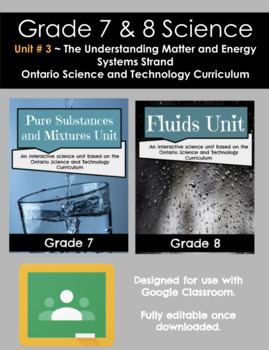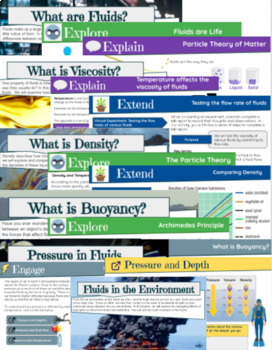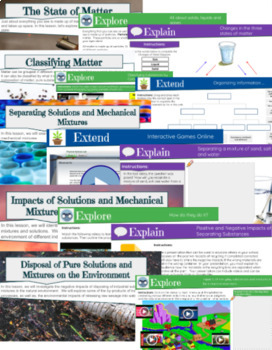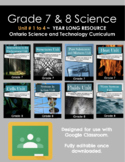Grade 7&8 Science Unit Bundle (STRAND 3 - Understanding Matter and Energy)
- Zip
What educators are saying
Products in this Bundle (2)
Also included in
- In this bundle, I have added all four Grade 7 Science and Technology Units. These lessons were made as a resource for my students "learning from home". Each lesson is was created with Ontario Science and Technology curriculum in mind.Unit 1 ~ Interactions in the Ecosystem (Nine Interactive Lessons)LPrice $93.60Original Price $104.00Save $10.40
Description
In this bundle, I have added the Grade 7 Pure Substance and Mixtures Unit and Grade 8 Fluids Unit. These lessons were made as a resource for my students "learning from home". Each lesson is was created with Ontario Science and Technology curriculum in mind.
Grade 7 Unit: Lesson Overview
LESSON # 1 ~ The States of Matter
Just about everything you see is made up of matter. Matter is anything that has mass and takes up space. In this lesson, let’s explore the theory of matter and changes of state.
LESSON # 2 ~ Classifying Matter
Matter can be grouped in different ways. It can be classified as a solid, liquid, or a gas. It can also be classified by what it is made up of. In this lesson, we will explore the composition of matter; pure substances and mixtures.
LESSON # 3 ~ Solutions: Concentration and Solubility
In this lesson, we will examine the concentration and solubility of various solutions. We will also explore the difference between solutes and solvents.
LESSON # 4 ~ Separating Solutions and Mechanical Mixtures
In this lesson, we will examine the methods used to separate various solutions and mechanical mixtures.
LESSON # 5 ~ Impacts of Solutions and Mechanical Mixtures on the Environment
In this lesson, we will identify industrial applications of the processes used to separate mixtures and solutions. We will also assess the impacts on society and the environment of different industrial methods of separation of these substances.
LESSON # 6 ~ Disposal of Pure Solutions and Mixtures on the Environment
In this lesson, we will investigate the negative impacts of disposing of industrial substances and mixtures in the natural environment. We will explore some of the by-products of industrial processes, as well as, the environmental impacts of releasing raw sewage into waterways.
Grade 8 Unit: Lesson Overview
LESSON #1 ~ What are Fluids?
Fluids make up a large part of our surroundings. They are so much a part of our lives that we often take little notice of them. In this lesson, we will explore the uses of everyday fluids, as well as, explain the differences between solids, liquids, and gases, using the particle theory of matter.
LESSON #2 ~ What is Viscosity?
One property of fluids is how they move or flow. What would happen if these fluids did not flow the way they usually do? In this lesson, we will explore, compare, and explain the viscosity of various fluids. We will examine how temperature affects the flow rate of liquids and gases.
LESSON #3 ~ What is Density?
Density describes how closely packed together the particles are in a substance. In this lesson, we will explore and compare the densities of various fluids. We will also learn how to calculate the densities of these liquids and determine which will sink and which will float.
LESSON #4 ~ What is Buoyancy?
Have you ever wondered why some things float and others sink? What is the connection between an object’s density and the forces that act on it in a fluid? In this lesson, we will explore the forces that affect fluids, Archimedes Principle, and how it relates to natural and man-made materials in everyday life.
LESSON #5 ~ Pressure in Fluids
Pressure is the amount of force applied to a given area. It can increase with depth or a change in altitude. In this lesson, we will explore how pressure in fluids move from an area of high concentrations to an area of low concentration. We will also explore how pressure systems, such as hydraulic and pneumatic systems work in everyday objects.
LESSON #6 ~ Fluids and the Environment
From the air, we breathe, to the water we drink, and the fuels that we put into our cars, fluids are a part of our daily lives. Every so often, we may hear stories on the news of accidental oil spills or toxic chemicals being released into our atmosphere. In this lesson, we will explore the damaging effects of fluid spills on the environment and determine if we can prevent such disasters in the future.





